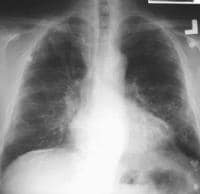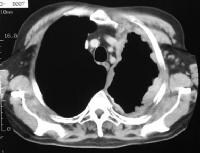Chance Fracture of the Spine
- Discussion:
- Chance frx & posterior ligament rupture (variant of flexion distraction injury pattern) may
present w/ minor anterior vertebral compression;
- in Chance frx, the anterior column fails in tension (along w/ the middle and posterior columns),
where as flexion distraction fracture involve compression of the anterior column and
distraction of the middle and posterior columns;
- approx 1/2 of pts w/ flexion distraction injury pattern have primarily ligamentous rupture;
- rupture usually includes interspinous ligament, ligamentum flavum, facet capsule, posterior
annulus, and thoracodorsal fascia;
- whether the injury is purely ligamentous or includes a fracture thru vertebral body, all three columns
rupture in distraction (tension);
- often these are misdiagnosed as a compression frx;
- the occurance of a traumatic compression fracture in a young patient (following MVA) should
raise the possibility of a Chance fracture;
- either good quality AP view is necessary to rule out posterior element injury, or a CT scan is
required (if the AP view remains equivocal);
- Exam:
- seldom assoc w/ neurologic compromise unless
- abdominal injuries are common and occur in upto 50-60% of patients;
- references:
- The epidemiology of seatbelt associated injuries.
PA Anderson et al. J. Trauma. Vol 31. 1991. p 60-67.
- Radiographs:
- significant translation on lateral;
- anterior wedging may be minimal;
- often only a portion of the vertebral body will be involved (half ligamentous and half bony injury);
- look for frx line extending thru spinous process, lamina, pedicles, & portion of the vertebral body;
- often the AP view will best show the posterior element injury (lamina frx will appear as a "lazy W")
- CT Scan: is often ordered to help make the diagnosis;



- Non Operative Treatment:
- Chance Frx may initially be unstable, but after 2 weeks there will be sufficient bony healing
to allow fitting for an orthosis;
- patients w/ partial vertebral body involvement (half bony injury and half ligamentous injury)
may be candidates for non operative treatment is alignment is acceptable;
- candidates for non operative treatment should have less than 15 deg of kyphosis;
- patients should be fitted for a custom molded hyperextension orthosis;
- fractures below L3 may require the addition of a thigh extension;
- Indications for Operative Treatment:
- w/ Ligamentous Chance Injury, soft tissue healing is unreliable, and about
half of all patients treated non operatively will have poor outcomes;
- progressive kyphosis is one of the major complications w/ non-op Rx;


























